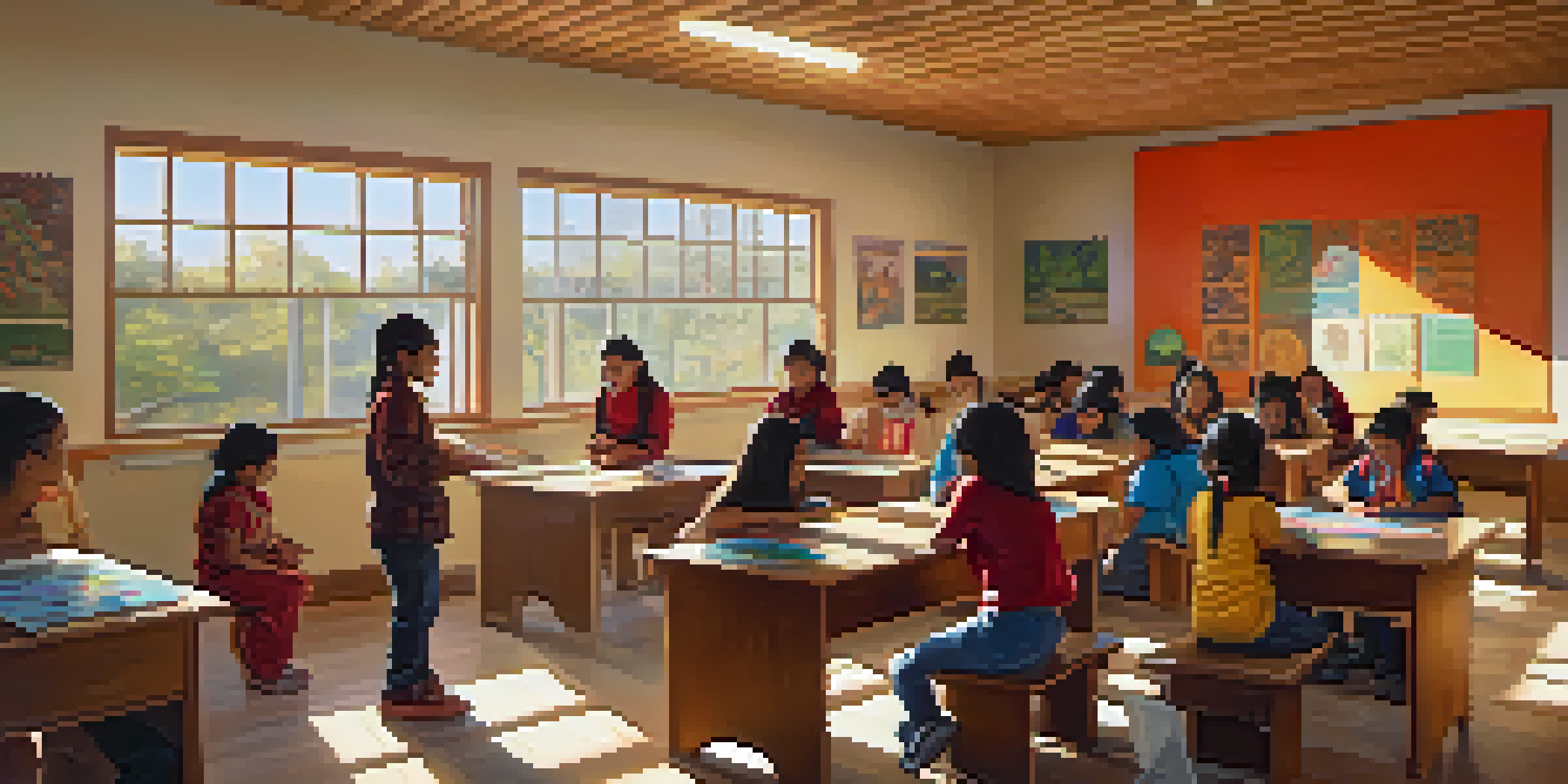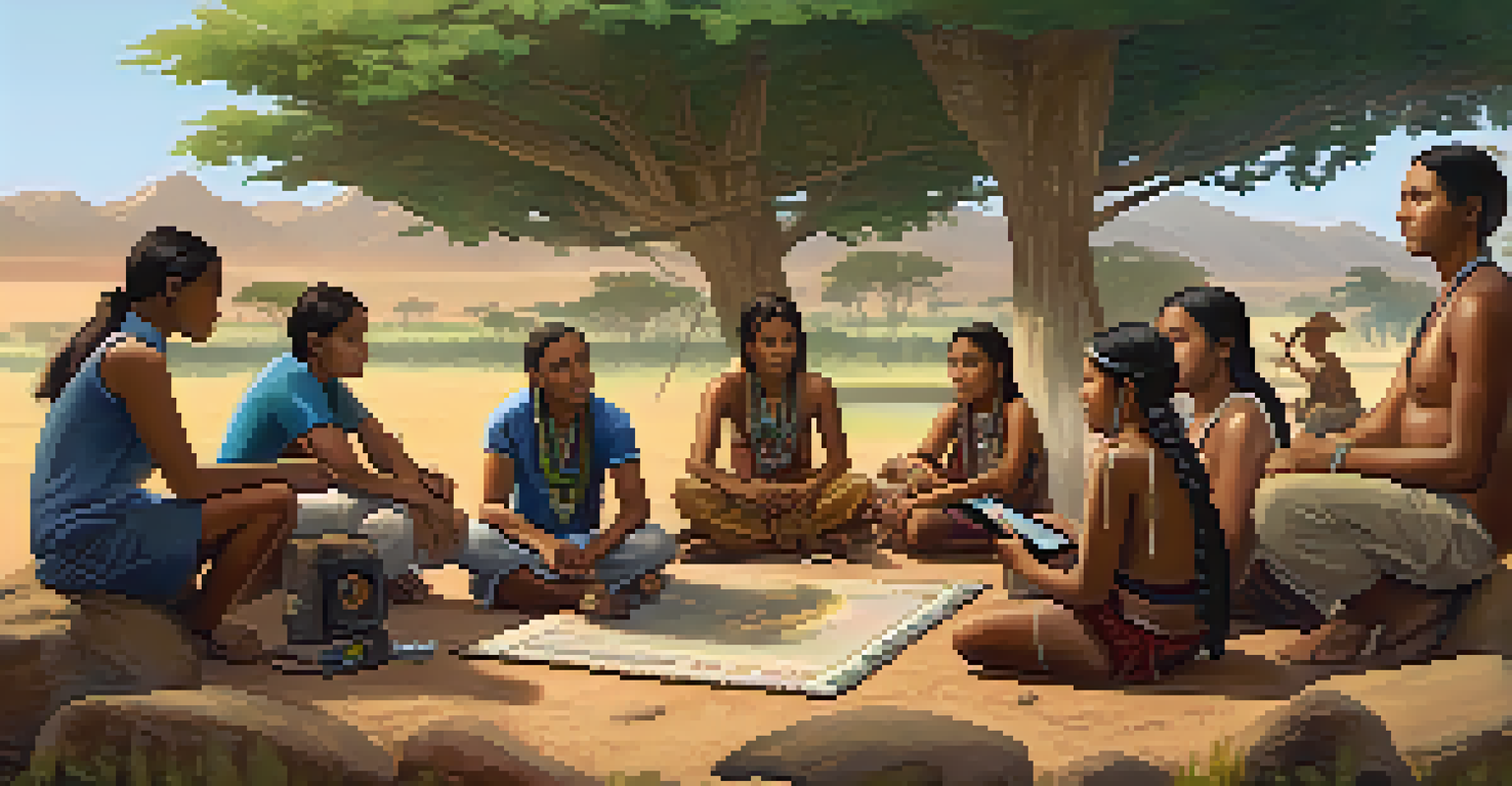The Impact of Globalization on Indigenous Education Practices

Understanding Globalization and Its Reach
Globalization refers to the interconnectedness of cultures, economies, and societies worldwide. It facilitates the exchange of ideas, goods, and practices across borders, ultimately impacting various aspects of life, including education. For indigenous communities, globalization can bring both opportunities and challenges, reshaping traditional ways of learning.
Globalization is not a monolithic process; it has a variety of forms, and its effects can be both positive and negative.
As global influences permeate local cultures, indigenous education practices may adapt or transform, often leading to the integration of new pedagogies. However, this may also risk diluting unique cultural identities and knowledge systems that have been passed down through generations. Understanding the balance between embracing global trends and preserving local heritage is crucial.
Moreover, globalization has increased awareness of indigenous rights and educational needs on an international scale. This heightened visibility can lead to greater support for indigenous education initiatives, fostering collaborations that aim to enrich learning experiences while honoring traditional practices.
Cultural Exchange: A Double-Edged Sword
The exchange of cultural practices through globalization can enrich indigenous education by introducing new perspectives and methodologies. For instance, indigenous educators might adopt innovative teaching techniques from around the world, enhancing student engagement and learning outcomes. This cross-pollination of ideas can foster a more dynamic educational environment.

However, this cultural exchange can also pose threats to indigenous knowledge systems. When outside influences overshadow traditional teachings, there is a risk of eroding the richness of indigenous cultures. This highlights the need for a careful approach that respects and incorporates indigenous wisdom alongside global practices.
Globalization's Impact on Education
Globalization connects cultures and influences indigenous education, presenting both opportunities for growth and risks of cultural dilution.
Finding a balance between integrating beneficial global practices and maintaining cultural integrity is essential. Indigenous communities must navigate these complexities to ensure that their educational frameworks remain relevant and true to their values.
Impact on Language and Communication Styles
Language is a cornerstone of culture, and globalization significantly impacts indigenous languages. As dominant global languages like English and Spanish gain prominence, many indigenous languages face extinction, leading to a loss of unique worldviews and knowledge. This shift can have profound implications for education, as language is often the medium through which cultural teachings are conveyed.
The preservation of indigenous cultures is a matter of survival, not just for the indigenous people, but for humanity as a whole.
In educational settings, the prevalence of global languages can create barriers for indigenous students, who may struggle to engage fully in a system that prioritizes non-native tongues. This situation underscores the importance of bilingual education models that honor and incorporate indigenous languages, fostering both language preservation and academic success.
Additionally, communication styles influenced by globalization may clash with traditional ways of interaction. Educators need to be mindful of these differences to create a learning environment that respects indigenous communication norms while also preparing students for a globalized world.
The Role of Technology in Indigenous Education
Technology plays a pivotal role in education today, and its integration into indigenous learning practices can be transformative. Access to digital tools and resources can enhance the educational experience, allowing for the documentation and dissemination of indigenous knowledge on a broader scale. Online platforms can serve as bridges that connect indigenous communities with global audiences.
However, reliance on technology also presents challenges. Not all indigenous communities have equal access to the internet or digital resources, which can exacerbate existing inequalities. It’s crucial to consider these disparities when implementing technological solutions in indigenous education.
Balancing Tradition and Innovation
Indigenous communities must navigate the integration of global teaching methods while preserving their unique cultural identities and knowledge systems.
Moreover, the use of technology should be approached thoughtfully, ensuring that it complements rather than replaces traditional teaching methods. By leveraging technology in a way that respects and honors indigenous ways of knowing, educators can create a more inclusive and effective learning experience.
Educational Policies and Indigenous Rights
Globalization has spurred discussions around educational policies that recognize and protect indigenous rights. International agreements, like the United Nations Declaration on the Rights of Indigenous Peoples (UNDRIP), advocate for the inclusion of indigenous perspectives in education. Such frameworks can empower communities to assert their educational sovereignty and promote culturally relevant curricula.
However, the implementation of these policies can be inconsistent, often dependent on local governments' commitment to honoring indigenous rights. Advocacy and activism from indigenous leaders and communities are essential to hold policymakers accountable and ensure that educational practices reflect their unique needs and aspirations.
This ongoing dialogue between global policies and local realities illustrates the importance of involving indigenous voices in decision-making processes. By prioritizing indigenous perspectives, educational systems can create more equitable opportunities for all learners.
Challenges of Cultural Homogenization
One significant challenge posed by globalization is cultural homogenization, where distinct cultural identities blend into a singular global culture. This phenomenon can lead to the marginalization of indigenous knowledge systems, as traditional practices may be overshadowed by more dominant narratives. The impact on education is profound, as students may receive a diluted version of their cultural heritage.
In educational contexts, this can manifest as a lack of representation of indigenous histories, languages, and worldviews in curricula. When indigenous content is not prioritized, students may struggle to connect with their cultural roots, leading to a sense of disconnection from their identity. This underscores the importance of developing curricula that honor and reflect indigenous perspectives.
Empowering Through Indigenous Knowledge
Revitalizing traditional knowledge systems can strengthen cultural identity and resilience among indigenous communities in a globalized world.
Addressing cultural homogenization requires a concerted effort from educators, policymakers, and communities. By actively promoting indigenous knowledge and practices within educational systems, we can create a richer, more inclusive learning environment that values diversity.
Empowerment through Indigenous Knowledge Systems
Despite the challenges posed by globalization, there is a growing movement to empower indigenous education through the revitalization of traditional knowledge systems. Many indigenous communities are recognizing the importance of teaching their languages, stories, and cultural practices to younger generations. This movement not only strengthens cultural identity but also enhances the community's resilience against external pressures.
Integrating indigenous knowledge into formal education can create a more holistic learning experience. For example, lessons that incorporate traditional ecological knowledge can provide students with valuable insights into sustainability and environmental stewardship. This approach not only preserves cultural heritage but also equips students with practical skills for navigating contemporary challenges.

Ultimately, empowering indigenous education requires a collaborative effort among educators, community leaders, and students. By working together to honor and incorporate indigenous knowledge, we can foster a sense of pride and belonging among learners, ensuring that their cultural heritage thrives in a globalized world.